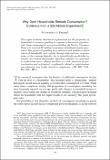Why Don’t Households Smooth Consumption? Evidence from a $25 Million Experiment
Author(s)
Parker, Jonathan A.
Downloadmac.20150331.pdf (553.2Kb)
PUBLISHER_POLICY
Publisher Policy
Article is made available in accordance with the publisher's policy and may be subject to US copyright law. Please refer to the publisher's site for terms of use.
Terms of use
Metadata
Show full item recordAbstract
This paper evaluates theoretical explanations for the propensity of households to increase spending in response to the arrival of predictable, lump-sum payments, using households in the Nielsen Consumer Panel who received $25 million in randomly distributed stimulus payments. The pattern of spending is inconsistent with models in which identical households cycle rapidly through high and low- response states as they manage liquidity, but is instead highly predictable by income years before the payment. Spending responses are unrelated to expectation errors, almost unrelated to crude measures of procrastination and self-control, significantly related to sophistication and planning, and highly related to impatience.
Date issued
2017-10Department
Sloan School of ManagementJournal
American Economic Journal: Macroeconomics
Publisher
American Economic Association
Citation
Parker, Jonathan A. “Why Don’t Households Smooth Consumption? Evidence from a $25 Million Experiment.” American Economic Journal: Macroeconomics 9, 4 (October 2017): 153–183 © 2017 American Economic Association
Version: Final published version
ISSN
1945-7707
1945-7715